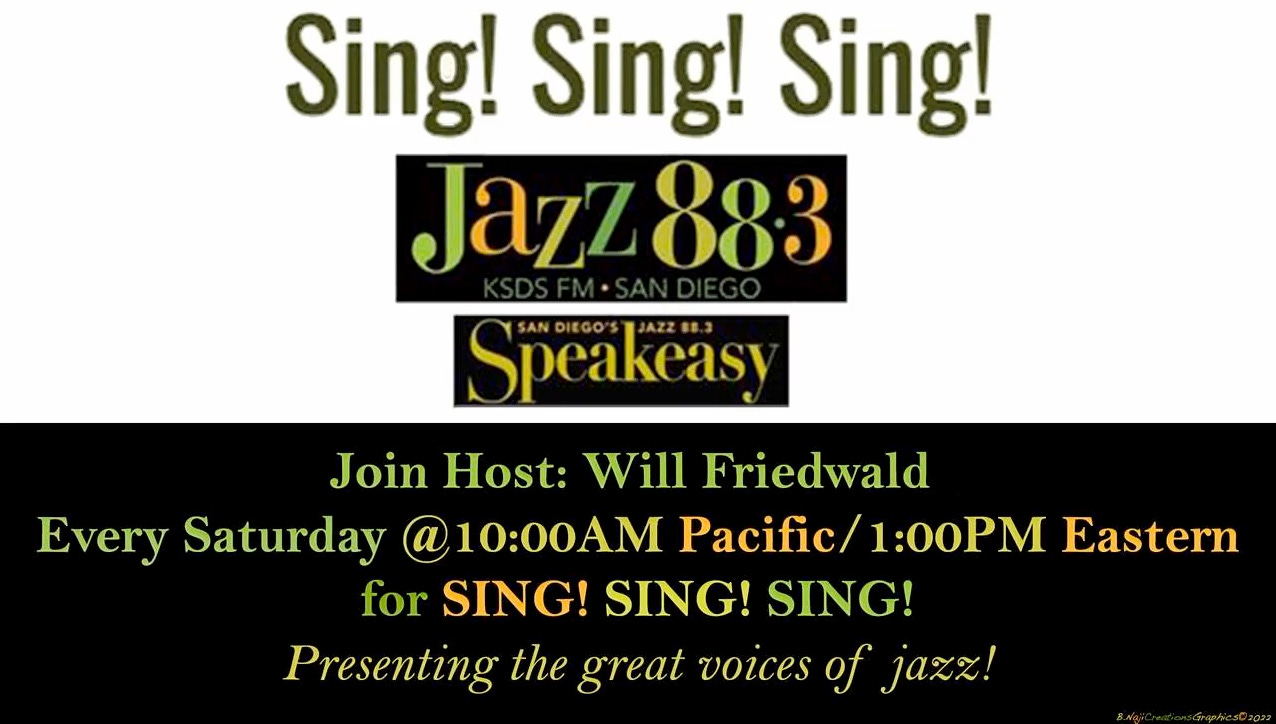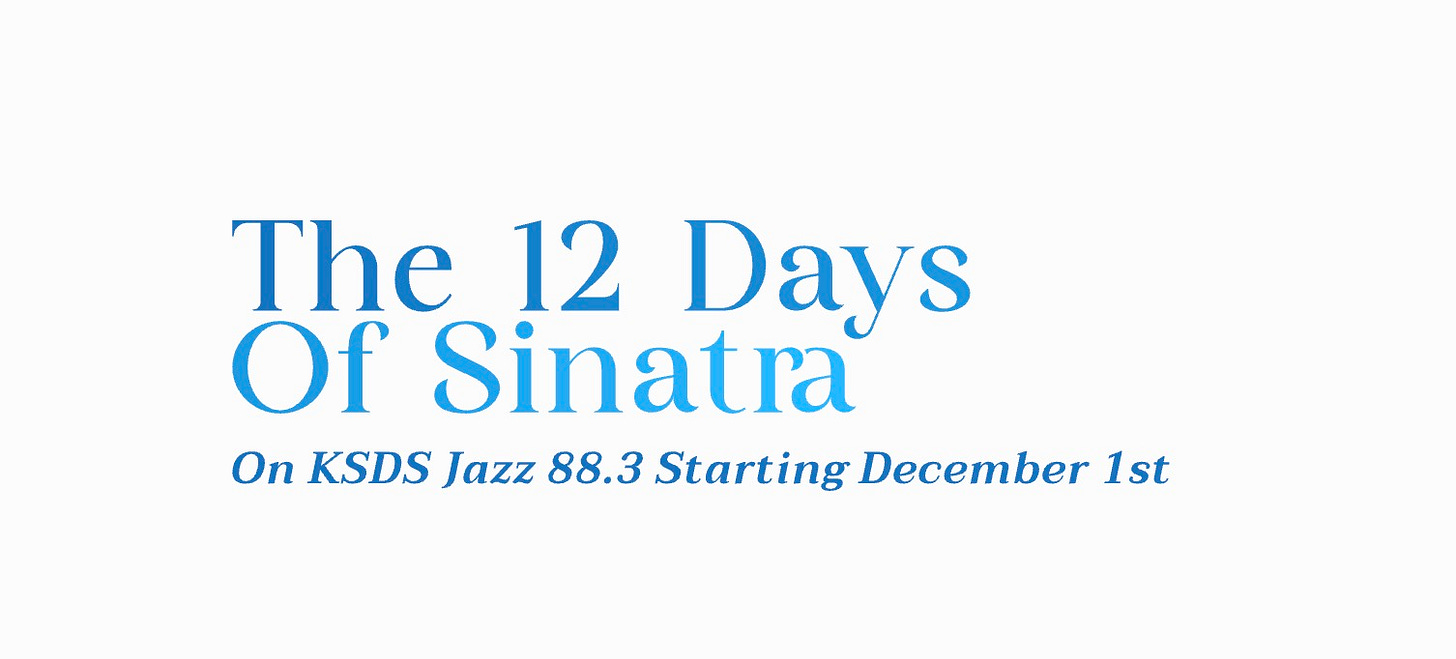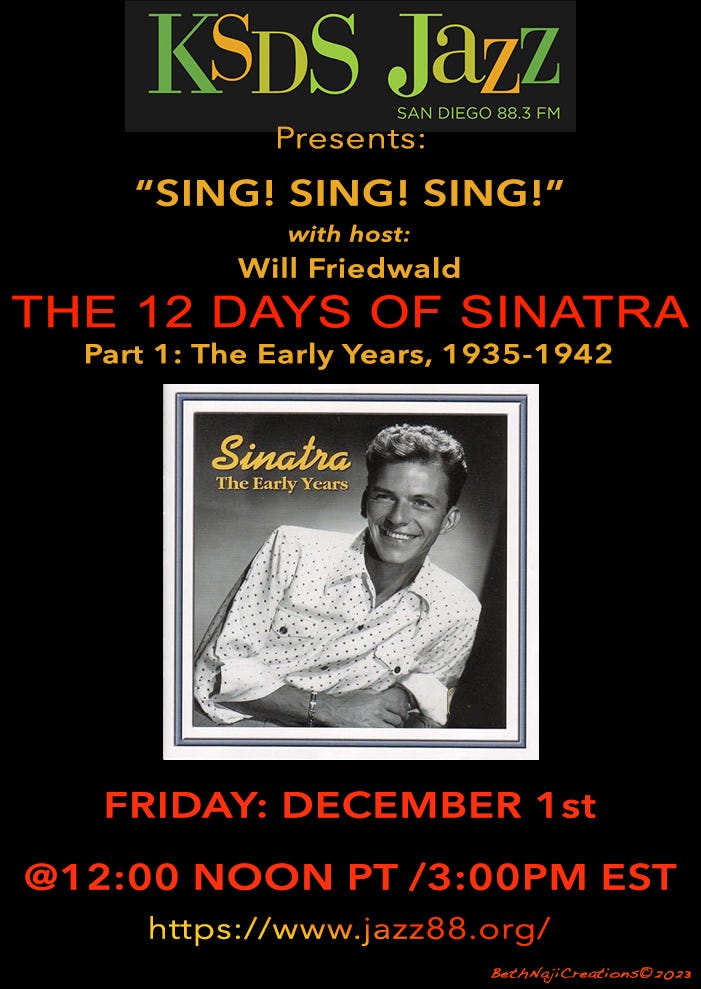Right around the time that Sinatra died in 1998, Chuck Granata and I were contacted by two young saxophone players, Jonathan O'Donnell, and Robert Mandelbaum, who were representing Frank Mane. (You’ll read a lot about who he was very shortly.) Their objective was to get Frank Sinatra’s first-ever studio recording released commercially - this almost exactly 60 years after it was made, and 25 years ago. They were working with the veteran producer Arthur Shimkin. Alas, their combined efforts led nowhere; the track has still never been released, even though it’s readily available on youTube.com and elsewhere. At the time, I was commissioned to write a full essay for the planned package, and I wound up putting down nearly 5,000 words - which may strike you as an extravagant quantity of verbiage to accompany a four-minute recording.
Although the package was never released - Chuck and I were grateful to make the acquaintance of Jonathan and Robert, and especially also of Frank Mane himself - we met him a few times before he died in 1998, not long after Sinatra - and also to Arthur, who would become a dear friend before he died at the age of 84 in 2006.
Chuck told the story of “Our Love” very expertly in his highly-recommended 1999 book, Sessions With Sinatra. I also included a version of the story in the 2018 edition of my own Sinatra! The Song is You. However, as we lead into Sinatra’s 108th birthday this year, I thought it might be instructive to publish the complete mega-essay in a series of installments here on SubStack. Hope you enjoy, hey!
(Special thanks to Chuck, of course, and to Michael “Contentious” Kraus and Rob Waldman for reading this through in advance. And as always to Elizabeth Zimmer!)
BEGINNINGS:
First recordings by major artists are often a source of consternation. Fans of Ella Fitzgerald (and who isn't?) were told often that the very first time she stepped into a studio she hit a bullseye with "A-Tisket, A-Tasket," the biggest hit of her entire career. Sadly, no. Fitzgerald's first waxing was "Love and Kisses," a song only dimly remembered for the fact of its being The Great Lady's premiere performance. Al Jolson's first authenticated disc, "That Haunting Melody," was not only not one of his signature anthems, but the lyric completely failed to mention either his Mammy or any state in the sunny south. Poor Bing Crosby had to wait at least five years from the time of his studio debut, the 1926 "I've Got The Girl," until he landed anything like a solo hit.
Later in his life, Frank Sinatra tended to introduce "All Or Nothing At All," which he recorded on August 31, 1939 with Harry James and his Orchestra, as the first record that he ever made. Sinatra said so on many occasions, among them his celebrated Concert for the Americas of 1982. It wasn't. Sinatra may or may not have forgotten that he had recorded other songs on earlier sessions with Harry James, however, "All Or Nothing At All" was certainly the earliest Sinatra song that the casual fan was likely to know, the first to become a hit. Most sources assume that the singer's first foray into a recording studio occurred on July 13, 1939 when Harry James waxed "From the Bottom Of My Heart," with a vocal refrain by the then-unknown Frank Sinatra
The earliest documents of Sinatra’s voice are two radio tracks from 1935, "Shine" and "The Curse of An Aching Heart," in which Young Blue Eyes is just barely heard as a member of the quartet then known as The Hoboken Four. Further, these tracks are radio airchecks, of dubious audio quality, taken down live from The Major Bowes Amateur Hour program (performed live on the stage of New York's Capitol Theatre) as opposed to studio recordings. The Bowes airchecks aside, as well as the sole documented appearance of another quartet, a unit known as "The Four Sharps" (a trio that Sinatra fronted on a 1937 radio appearance with Fred Allen, in which he banters with Allen but does not sing), "From the Bottom Of My Heart" would seem to qualify as the first official recording by Frank Sinatra.
Yet for decades, rumors of an earlier recording of the young Sinatra singing something called "Our Love" have been the source of much speculation. Since the late '70s, the track has been heard on bootleg Sinatra LPs, even though it has never been legitimately released. Even the most ardent of Sinatra scholars have been at a loss to explain exactly what this track was. Now, however, the disc itself is going to be legitimately available to at least one well-heeled fan because the owner is putting the disc itself up for sale at Guernsey's, the New York auction house that specializes in music and sports memorabilia.
From the evidence, "Our Love" was a "demo" of some sort made with an orchestra credited to someone named "Frank Mann" or "Manne." Somehow, the idea got around, possibly from Sinatra himself, that the singer had recorded this item at around the time of his wedding to the former Nancy Barbato, which inspired some discographers to put down a recording session of February 3, 1939, the day before the ceremony. According to some accounts, he even presented the new Mrs. Sinatra with a copy of the disc as a nuptial present. It was also speculated that this alleged demo was produced by Sinatra himself. This theory, however, fails to explain why the track is basically a band number. The singer is not featured all the way through but instead merely performs what was then called a "vocal refrain." (Actually, the structure of both the original song and the arrangement isn't quite that simple, as we'll examine later on.)
Searches through phone books on Sinatra's home turf, the Hoboken-Jersey City area, failed to produce an individual named "Frank Mann." Only a few of the many published Sinatra biographies mention "Our Love" at all, and none of them – including my own – got the story straight. One fact that they do agree upon, and which turned out to be true, is that Sinatra recorded "Our Love" sometime before he joined Harry James in June 1939, making it the first of approximately 1,600 records that the singer would make in his six-decade career.
It wasn't until 1998 that the man himself emerged, coincidentally, in the year that both he and Sinatra died, and that the story behind “Our Love” became known; and even though it goes up for auction shortly, it seems unlikely that anybody except the one collector who buys it will get to hear it – legally, at least – any time soon.

FRANK MANE
"Frank Manne" is actually Frank Mane. He was born Francesco Mugnolo, near Naples, in 1904, and emigrated to New Jersey with his mother while still an infant. With the family name Americanized to Mane, he grew up studying the violin, and by the time he became a professional musician, in the early '20s, had also mastered clarinet. Mane also "tripled," as they used to say, on alto saxophone. As one of the first generation of saxophonists to work in American dance bands, Mane became a reed virtuoso in the era of Al Gallodoro, Arnold Brillhart, and Rudy Wiedoft. Mane spent most of the '20s and '30s playing in house orchestras at movie theaters in Jersey City, such as the Loew's and the Stanley.
It was around 1937, while employed by Jersey City radio station WAAT, that Frank Mane met the 21-year-old Sinatra, who was then picking up any work he could get at the station, usually for not much more than carfare. From the beginning, Sinatra called Mane "Cheech," which was the characteristic way that Italian-Americans named Frank referred to each other. In later years Sinatra would also address Columbia Records engineer Frank Laico as "Cheech," while Sinatra and aide-de-camp Frank Military also called each other "Big Cheech" and "Little Cheech." (For whatever reason, however, Mane himself never addressed Sinatra by that nickname.)
Unlike Sinatra, Mane owned a car. Mane has spent practically his whole life in Bayonne, and as it happened, on his way home from WAAT in downtown Journal Square, Mane drove past Audubon Avenue. Since Sinatra's then girlfriend, Nancy Barbato, lived on Audubon, Mane would often drop Sinatra off at the Barbato house on the way back from the station. The two men also hung out together around the espresso machine at Bayonne's "Sicilian Club," one of the many social and professional (and, in this case, ethnically specific) lodges that males of that pre-nuclear era frequently bonded in.
Part one of four - to be continued in part 2. (and yes, I am playing “Our Love” as part of the first day of “The 12 Days of Sinatra” on KSDS.)
Disclaimer: These are my memories of these incidents, nothing more, nothing less. I apologize in advance in case they may not line up precisely with anyone else’s account of what transpired on those occasions.
Very Special thanks to the fabulous Ms. Elizabeth Zimmer, for expert proofreading of this page, and scanning for typos, mistakes, and other assorted boo-boos!
Sing! Sing! Sing! : My tagline is, “Celebrating the great jazz - and jazz-adjacent - singers, as well as the composers, lyricists, arrangers, soloists, and sidemen, who help to make them great.”
A production of KSDS heard Saturdays at 10:00 AM Pacific; 1:00PM Eastern.
To listen to KSDS via the internet (current and recent shows are available for streaming.) click here.
The whole series is also listenable on Podbean.com, click here.
December 1: The Early Years 1935-42 hosted by Will Friedwald
December 4: The Columbia Years 1943-’49 hosted by Ken Poston
December 5: The Radio Years: hosted by Chuck Granata
December 6: The Fall and Rise (1950-’54) hosted by Will Friedwald
December 7: Frank and Nelson hosted by Will Friedwald
December 8: The Capitol Years hosted by Loren Schoenberg
December 9: Bonus! Sing! Sing! Sing! Some Frank Conversation with Adam Gopnik
December 11: The Movies: Hosted by Chuck Granata
December 12: The Early Reprise Years 1960-'65 hosted by Loren Schoenberg
December 13:The Concert Years hosted by Ken Poston
December 14: The Rat Pack hosted by Ken Poston
December 15: Inside the Studio hosted by Chuck Granata
December 18: 1965-1974 The Main Event hosted by Will Friedwald
SLOUCHING TOWARDS BIRDLAND is a subStack newsletter by Will Friedwald. The best way to support my work is with a paid subscription, for which I am asking either $5 a month or $50 per year. Thank you for considering. (Thanks as always to Beth Naji & Arlen Schumer for special graphics.) Word up, peace out, go forth and sin no more! (And always remember: “A man is born, but he’s no good no how, without a song.”)
Note to friends: a lot of you respond to my SubStack posts here directly to me via eMail. It’s actually a lot more beneficial to me if you go to the SubStack web page and put your responses down as a “comment.” This helps me “drive traffic” and all that other social media stuff. If you look a tiny bit down from this text, you will see three buttons, one of which is “comment.” Just hit that one, hey. Thanks!






"My Love" has been commercially available; I used to have it. Was it in the Complete Columbia? I can't remember.